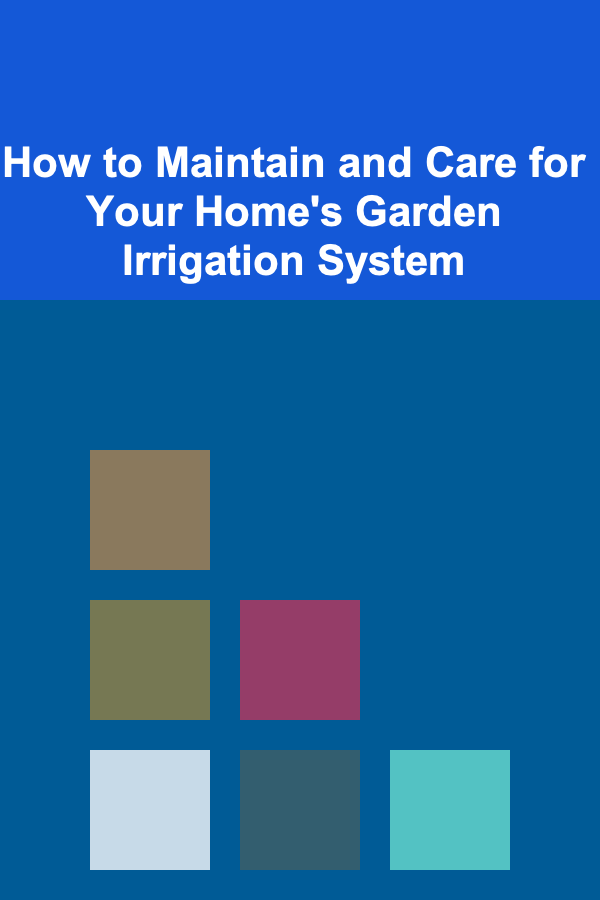
How to Maintain and Care for Your Home's Garden Irrigation System
ebook include PDF & Audio bundle (Micro Guide)
$12.99$8.99
Limited Time Offer! Order within the next:

Maintaining and caring for your home's garden irrigation system is essential for ensuring the health and beauty of your garden while also maximizing water efficiency. An efficient irrigation system can save you both time and money, but if not properly maintained, it can lead to water wastage, plant stress, and costly repairs. Proper irrigation care involves routine checks, cleaning, adjusting, and upgrading to keep the system in good working order.
In this comprehensive guide, we'll explore the various aspects of irrigation system maintenance, covering everything from troubleshooting common issues to performing seasonal checks. Whether you have a drip irrigation system, a sprinkler system, or a combination of both, this article will provide you with the knowledge and tools you need to keep your garden flourishing.
Understanding Your Garden Irrigation System
Before diving into the maintenance practices, it's important to understand the basic components of a garden irrigation system. Different systems may have slight variations, but most residential irrigation setups consist of the following key parts:
1. Water Source
This is where the system draws water from, such as a municipal water supply, a well, or a rainwater harvesting system.
2. Backflow Preventer
This device prevents water from flowing backward into the potable water supply, ensuring that the water supply remains uncontaminated.
3. Valves
Valves control the flow of water through different parts of the system. They allow for precise watering of individual zones in the garden.
4. Pipes and Tubing
Pipes and tubing carry water to the various components of the system, distributing it evenly to the garden. These pipes are typically buried underground or installed along the surface.
5. Emitters
Emitters are responsible for releasing water into the soil in a controlled manner. In a drip irrigation system, emitters regulate the flow of water to specific plants or areas.
6. Sprinklers or Sprayer Heads
Sprinklers distribute water across the garden in a mist or spray pattern. They are commonly used in lawns and large garden beds.
7. Timer or Controller
The timer or controller is used to automate the system, allowing you to set specific watering schedules and durations. Modern controllers often include smart features for weather adjustments and remote control via smartphone apps.
Understanding these components will help you diagnose problems and perform maintenance tasks more effectively.
Routine Maintenance for Your Irrigation System
1. Check for Leaks and Damage
Leaks and damage can significantly reduce the efficiency of your irrigation system and lead to water waste. Regularly inspect all visible parts of the system, including the pipes, emitters, sprinkler heads, and valves, for signs of leaks, cracks, or clogs.
How to Inspect for Leaks:
- Sprinkler Heads: Look for signs of water pooling around the sprinkler heads, which may indicate a leak.
- Drip Irrigation Tubing: Check for drips or wet spots along the tubing that could signify a cracked or damaged section.
- Valves and Connections: Examine the valve boxes for any puddles of water, which could indicate a leaking valve or connection.
If you find any leaks, repair them promptly by replacing damaged parts or tightening loose connections. For buried pipes, consider calling a professional if you are unsure how to locate and fix leaks.
2. Clean the Filters and Emitters
Debris, mineral buildup, and algae can clog filters and emitters, reducing the flow of water and impacting the efficiency of your irrigation system. Cleaning the filters and emitters regularly will ensure that water is being distributed evenly and properly.
How to Clean Filters:
- Drip Irrigation Systems: Remove the filter from the filter housing and rinse it under clean water. If the filter is particularly clogged, soak it in vinegar or a mild cleaning solution to remove mineral deposits.
- Sprinkler Systems: Many sprinkler heads have small filters located at the base. Remove the sprinkler heads and clean the filters to ensure water can flow freely.
How to Clean Emitters:
- For drip irrigation, remove each emitter and soak it in a cleaning solution for a few hours before rinsing it with clean water.
- If the emitter is clogged with dirt or algae, use a pin or needle to carefully clear the opening.
3. Inspect and Adjust Sprinkler Heads
Sprinkler heads can become misaligned over time due to lawnmowers, foot traffic, or general wear and tear. Misaligned sprinkler heads can waste water by spraying it onto walkways, fences, or the sides of your house instead of your garden.
How to Inspect and Adjust Sprinkler Heads:
- Turn on the system and observe each sprinkler head's spray pattern.
- Use a wrench to adjust the height of the sprinkler head or turn the nozzle to change the spray pattern. You can also adjust the arc of the sprinkler to ensure water is being directed where it's needed.
Make sure that sprinklers are not obstructed by grass, plants, or debris. Keep the heads clean and ensure they pop up and retract properly.
4. Inspect and Test the Timer/Controller
Your irrigation system's timer or controller is responsible for setting watering schedules and ensuring the system runs at the correct times. If the timer isn't functioning properly, your garden could be overwatered or underwatered.
How to Inspect the Timer:
- Check the timer's battery (if applicable) and replace it if necessary.
- Test the controller to ensure it is triggering each valve and zone properly. If the timer isn't working as expected, consult the user manual for troubleshooting or contact a professional for assistance.
- Ensure that the watering schedule is still appropriate for the season. For example, your system might need to water less frequently during the cooler months or more frequently during the summer.
5. Adjust for Seasonal Changes
Your garden's water needs change with the seasons. During the warmer months, plants require more water, while during the cooler months, less water is needed.
How to Adjust for Seasonal Changes:
- Increased Watering in Summer: In hot climates, increase watering durations and frequency to keep plants hydrated. If you have a smart controller, it may adjust the watering schedule automatically based on the weather.
- Reduced Watering in Winter: In winter, you may need to reduce watering or even shut off the irrigation system entirely if rainfall is sufficient and temperatures are low. If you live in an area with freezing temperatures, you may need to drain the system to prevent pipes from bursting.
Seasonal Tasks for Your Irrigation System
Different seasons bring specific challenges and requirements for maintaining your irrigation system. Let's break down the key tasks for each season to keep your system running smoothly.
1. Spring: Start-Up and Inspection
In the spring, it's time to prepare your irrigation system for the growing season. Before you start using the system, perform a thorough inspection to ensure everything is in good working order.
Spring Maintenance Checklist:
- Inspect for Leaks and Damage: Look for leaks, cracks, and other damage that might have occurred during the winter months.
- Check the Controller: Make sure the timer is functioning properly and set it according to the season's watering needs.
- Test the System: Run the system to check the functionality of sprinklers, emitters, and valves. Test each zone to ensure that water is flowing properly.
2. Summer: Monitoring and Adjusting
Summer brings the highest water demand for most gardens. Your irrigation system needs to be adjusted for increased watering needs, and you should monitor the system regularly to ensure it's working efficiently.
Summer Maintenance Tips:
- Increase Watering Frequency: Depending on the temperature and plant needs, you may need to increase watering duration and frequency.
- Check for Clogs: The hot weather can lead to increased evaporation, so check for any clogs in sprinkler heads or drip emitters.
- Inspect Sprinkler Heads: Ensure that sprinkler heads are not blocked by plants or debris, and adjust their spray pattern to ensure water is being directed properly.
3. Fall: Adjusting and Preparing for Winter
As the weather cools down, it's time to prepare your irrigation system for the winter months. Fall is a crucial time for shutting down and maintaining your system to prevent damage from freezing temperatures.
Fall Maintenance Checklist:
- Reduce Watering: As the weather cools, reduce the watering frequency and duration.
- Flush the System: Flush the irrigation lines to remove any debris or standing water that could freeze and cause damage.
- Winterize the System: In areas with freezing temperatures, drain the irrigation lines, blow out excess water, and shut off the water supply to prevent freezing and bursting pipes.
4. Winter: Protecting and Storing
Winter is the season of rest for your irrigation system, but you still need to protect it from the elements. This is the time to ensure that all components are properly stored or winterized to prevent damage during cold weather.
Winter Care Tips:
- Shut Off Water Supply: Ensure the water supply to the irrigation system is completely shut off.
- Protect Exposed Components: For systems with exposed components, cover them with insulating materials or protective covers to prevent damage from freezing temperatures.
Troubleshooting Common Irrigation Problems
Even with regular maintenance, you may encounter problems with your irrigation system. Here are some common issues and how to troubleshoot them:
1. Water Pressure Problems
If your system is not distributing water evenly, it could be due to low water pressure. Check for clogs, leaks, or a malfunctioning pressure regulator. You can also check the water supply to ensure that pressure is adequate.
2. Uneven Watering
Uneven watering may result from misaligned sprinkler heads, clogged emitters, or faulty valves. Ensure that the sprinkler heads are properly adjusted, and check that all emitters are functioning as expected.
3. Overwatering or Underwatering
If your plants are wilting or showing signs of stress, the system may be watering too much or too little. Check the timer settings, the water flow, and the moisture levels in the soil to ensure the system is delivering the right amount of water.
Conclusion
Maintaining and caring for your garden's irrigation system is a continuous process that requires attention to detail and routine checks. By performing regular maintenance, inspecting for damage, adjusting settings for seasonal changes, and troubleshooting common issues, you can keep your irrigation system functioning efficiently and ensure that your garden remains healthy and beautiful throughout the year.
Reading More From Our Other Websites
- [Paragliding Tip 101] From #) KM/H to @)) KM/H: Milestones in Paragliding Speed History
- [Home Soundproofing 101] How to Choose Between Soundproofing Foam and Acoustic Panels
- [Home Family Activity 101] How to Organize a Family Night of Karaoke Fun
- [Horseback Riding Tip 101] Everyday Hacks to Keep Your Horse Comfortable on Long Rides
- [Personal Care Tips 101] How to Choose a Shampoo That Helps with Scalp Acne
- [Ziplining Tip 101] From Fear to Freedom: My Day Ziplining Over the World's Most Spectacular Falls
- [Organization Tip 101] How to Write Meaningful Letters for Future Generations
- [Home Space Saving 101] How to Implement Genius Small Bedroom Organization Strategies for Kids' Rooms to Keep Toys and Clothes Tidy
- [Home Family Activity 101] How to Plan a Family Trip to the Zoo
- [Organization Tip 101] How to Use Apps to Manage Home Projects Efficiently

Creating Inclusive Communities: A Social Worker's Handbook
Read More
How to Use Dimmer Switches to Control Your Home's Lighting
Read More
How to Market Your Blockchain Project to a Global Audience
Read More
How to Exercise at Home for Weight Loss
Read More
How to Build a Fire Safety Plan for Your Business
Read More
How to Make Cheese Curds from Raw Milk
Read MoreOther Products

Creating Inclusive Communities: A Social Worker's Handbook
Read More
How to Use Dimmer Switches to Control Your Home's Lighting
Read More
How to Market Your Blockchain Project to a Global Audience
Read More
How to Exercise at Home for Weight Loss
Read More
How to Build a Fire Safety Plan for Your Business
Read More